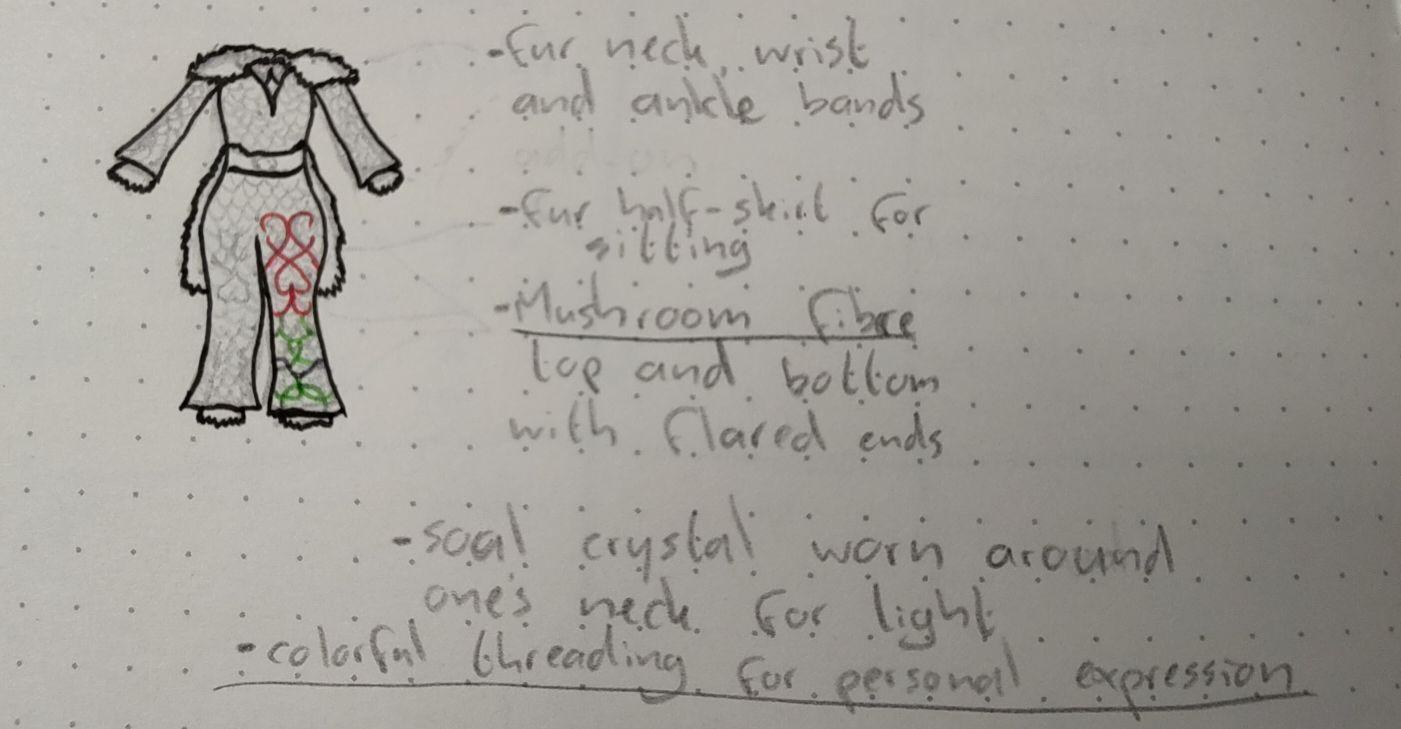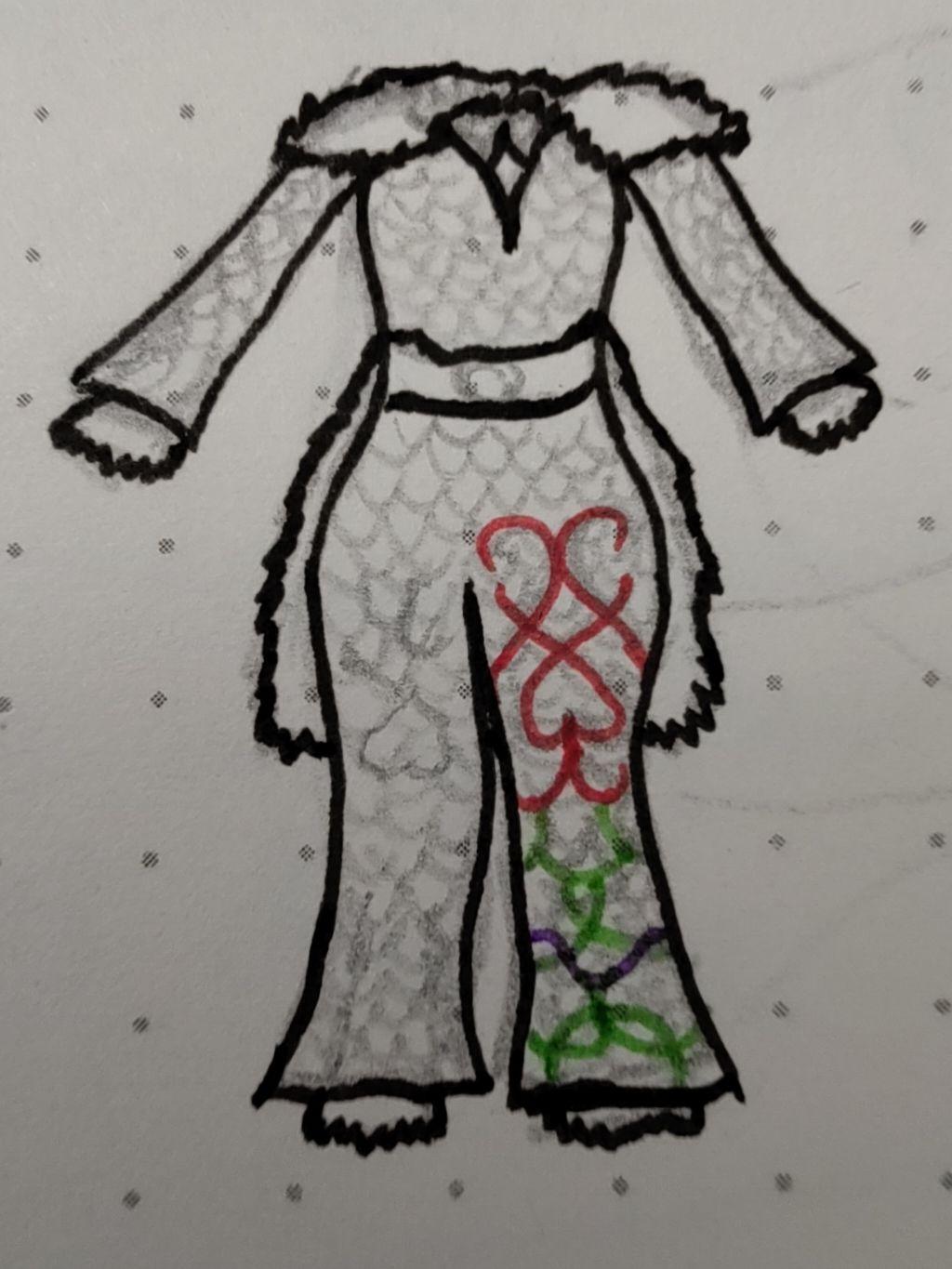Miraki clothing
Miraki clothing is a style of clothing where small patches of tough fibre are woven together. It has a chaotic look to it. Large bits of fabric resemble fish scales. The patches are woven together with colourful threads to express personality. It is usually worn in combination with soft ankle, wrist and neck protection.
Later, during the Cold Age, when de dwarves ventured out of the caves into the frozen surface world, this clothing persisted for quite a while. However, the cold weather and presence of wild animals made it so they wore thick layers of fur underneath their Miraki clothing. The fur kept them warm and was soft to the touch, and the Miraki kept them dry and made the fur last longer. Over time, when some clans moved further away from the caves, they lost access to Mirak mushrooms and started to wear only leather and fur clothing. Only among the Escar and the Bar Kádi still remain some craftspeople who truly know how to make miraki clothing.
Red: Linked with outspokenness, crudeness, and wealth. Often worn by cooks and craftsmen.
Brown: Linked with groundedness, introspection. No-nonsense and strength. Often worn by farmers.
Blue : Linked with adaptability and adventurousness. Often worn by gatherers and fishers.
Green: Linked with perseverance, growth and nostalgia. Often worn by builders and craftsmen.
Purple: Linked with kindness, community, and wisdom. Often worn by caretakers, elders, and healers.
By combining certain colours and patterns, themes can be designed, such as family, food, strength, animals, spirituality etc. Skilled weavers and people who remember the meanings can even tell simple stories using their threading technique. Most dwarves still link these colours loosely to personality traits and professions, but very few can still read full themes and stories woven in colour.
Material origin
Mirak fibre is the tough top 'skin' that covers the bulb of the Mirak mushroom. This skin is tough and waterproof, as it protects the mushroom from drying out and insects trying to eat it. This skin is too tough to eat, but when dried, it gains a leathery quality. This also makes the material very easy to clean as it is naturally dust and water repellent.History
Miraki clothing was developed during the long-gone Dwelling Days, when the dwarves lived in underground caves. With little soft fabric to work with, they looked towards other ways to make clothing. The fact that the Mirak fibre was waterproof, easy to clean, and very durable made it a good material for clothing. The rough edges, however, made it somewhat uncomfortable for direct skin contact . For this reason, the most exposed and movable edges like the neck, wrists and ankles were usually covered with a thin layer of fluff.Later, during the Cold Age, when de dwarves ventured out of the caves into the frozen surface world, this clothing persisted for quite a while. However, the cold weather and presence of wild animals made it so they wore thick layers of fur underneath their Miraki clothing. The fur kept them warm and was soft to the touch, and the Miraki kept them dry and made the fur last longer. Over time, when some clans moved further away from the caves, they lost access to Mirak mushrooms and started to wear only leather and fur clothing. Only among the Escar and the Bar Kádi still remain some craftspeople who truly know how to make miraki clothing.
Visual appearance and crafting technique
Dried Mirak skin takes on a roundish shape, but no two pieces are the exact same shape. These circular patches are woven one over the other. This creates the appearance of scales of fish, and it is indeed inspired by that. Each scale is attached via a thread to the other scales surrounding it. The Mirak fibre itself is not very supple, but thanks to the many small pieces threaded together, it remains surprisingly easy to move in. However, the rough edges of the fabric usually require the wearer to protect their ankles, wrists and neck with a soft fabric for comfort. Sometimes this even extends to the back-end, opening this part up in the Mirak fibre, and covering it in a soft half-skirt to make sitting more comfortable. Another solution is to wear a skirt that isn't too long on the back, so one doesn't have to sit on the rough edges of the Mirak fibre. Skilled tailors can create intricate patterns in the threading while still creating a sturdy piece of clothing. The patterns and the choice of colour can tell you a lot about the wearer.Colourweaving
The choice of colour used for the thread allows the wearer to signify their personality and affiliation with a particular skill or profession.Red: Linked with outspokenness, crudeness, and wealth. Often worn by cooks and craftsmen.
Brown: Linked with groundedness, introspection. No-nonsense and strength. Often worn by farmers.
Blue : Linked with adaptability and adventurousness. Often worn by gatherers and fishers.
Green: Linked with perseverance, growth and nostalgia. Often worn by builders and craftsmen.
Purple: Linked with kindness, community, and wisdom. Often worn by caretakers, elders, and healers.
By combining certain colours and patterns, themes can be designed, such as family, food, strength, animals, spirituality etc. Skilled weavers and people who remember the meanings can even tell simple stories using their threading technique. Most dwarves still link these colours loosely to personality traits and professions, but very few can still read full themes and stories woven in colour.
A simple sketch showing the scaly look, flared legs and arms, fur undercoat and a small piece of colour expression
Materials
- Dried skin/fibre of the Mirak mushroom creates the fabric called Miraki
- Colourful threads to signify personality and express themes
- Fur/fluff edges or undercoat
Item type
Clothing / Accessory




Comments